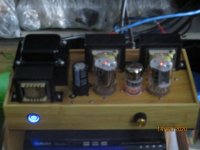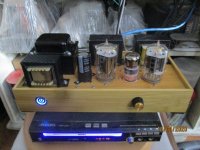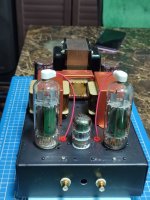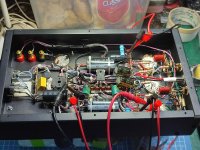Dear stenak, your question has me worried. Do you know enough to play with high voltage toys? Study, and be careful, man.
I’m thinking that “topcap” got bastardized by the spell checker. I don’t suspect bad grammar.
But yeah, you do have to deal with a FrankenLayout and have to be careful.
But yeah, you do have to deal with a FrankenLayout and have to be careful.
I have built 25 to 30 tubeamps since about 1990? Maybe 10 of them are still working..The rest of them are "reused" in New projects because I did not like the sound, finish?Dear stenak, your question has me worried. Do you know enough to play with high voltage toys? Study, and be careful, man.
Sad to read that you are worried. The reason for my question are because I have " never set my foot" in an El 36 tube before.I have built 25 to 30 tubeamps since about 1990? Maybe 10 of them are still working..The rest of them are "reused" in New projects because I did not like the sound, finish?
Am I right that the plate (anode) are connected from the to cap?
I am delighted to know you are an experienced amp builder. Apologies, and I did not mean to offend you, but when you asked a question that should be clear to you when you look at an EL36 data sheet I was not sure if you are a complete novice, or not.
Now that I know you can look it up on the datasheet go right ahead and find the anode connection 😉
https://frank.pocnet.net/sheets/030/e/EL36.pdf
The PL 36 is a nice tube, I drive it with a 6SN7. I tested it with OPT that a friend made for 45 tubes. Dissipation of 20 watt is no problem.
Note there were two very different tubes carrying the EL36 designation: The one we're talking about here, a line output beam tetrode and similar to PL36, and OTOH a Mullard tube similar to the ancient EL6 pentode.
Best regards!
Best regards!
At the very beginning of production, the MULLARD company produced EL6 tubes with an OCTAL base under the name EL36. This electron is relatively rare and is the same as the EL12 electron, but with a different base. Subsequently, the PHILIPS company (which was also the owner of the MULLARD company!) made an EL36 tube intended for the horizontal deflection stage in black-and-white televisions, which was significantly different from the EL36 tube produced earlier by the MULLARD company. The high-quality and well-made new EL36 tube from PHILIPS probably encouraged them to make experiments with that tube in the output stages of audio amplifiers. As a result of these experiments there were quite a number of amplifiers intended for professional use such as public address amplifiers for bus and railway stations, subways, schools, theaters, public events, stadiums, sports halls and many other uses where relatively high acoustic power was needed with very cheap (at that time!) output tubes.
Thanks for your additional, enlighting informations, Davorin 👍
👍👍!
The amplifiers you mentioned most probably are EL6405, EL6415 and EL6425 »typewriter« series, aren't they?
Btw, the 140 watt EL6435 also should be regarded member of this series, but features an almost vertical front and four PE06/40N's as finals, which resemble QE06/50 aka 807's, but are true pentodes.
Best regards!
👍👍!
The amplifiers you mentioned most probably are EL6405, EL6415 and EL6425 »typewriter« series, aren't they?
Btw, the 140 watt EL6435 also should be regarded member of this series, but features an almost vertical front and four PE06/40N's as finals, which resemble QE06/50 aka 807's, but are true pentodes.
Best regards!
Happy Newyear to all of You. Are the nobody out there with a schematic over the el 36 SE? A datasheet is great to have, but I feel that it is not necessary to reinvent the wheel? There are probably many schematics out there ?
Right now I went away from my workbench and a 1953 SABA Lindau GWIII table radio. It had a set of 100 mA series heated tubes that I swapped for 300 mA TV tubes. Here we go:
UC92 -> PC92
UF80 -> EF80
UCH81 -> ECH81
UF41 -> EF41 with resistors 68Ω||820Ω in parallel with it's 200 mA heater
UABC80 -> PABC80
UL41 ->PL82 (had also change the socket, of course)
UM85 -> EM85
I replaced the heater chain series resistors and the NTC by a 4.3 µF MP capacitor and both 18 V 0.1 A dial lamps by 3.8 V 0.3 A flashlight bulbs.
After turning it on, the radio worked immediately, and it worked better than before, 'cause most probably the UL41 power pentode had become tired and I've found a very fresh PL82 as it's replacement.
Best regards!
UC92 -> PC92
UF80 -> EF80
UCH81 -> ECH81
UF41 -> EF41 with resistors 68Ω||820Ω in parallel with it's 200 mA heater
UABC80 -> PABC80
UL41 ->PL82 (had also change the socket, of course)
UM85 -> EM85
I replaced the heater chain series resistors and the NTC by a 4.3 µF MP capacitor and both 18 V 0.1 A dial lamps by 3.8 V 0.3 A flashlight bulbs.
After turning it on, the radio worked immediately, and it worked better than before, 'cause most probably the UL41 power pentode had become tired and I've found a very fresh PL82 as it's replacement.
Best regards!
tv tubes rock!!! Happy New Year to all tube lovers out there...
here are two of my SEP's, single ended pentodes, no global negative feedback used..
output tubes were 12gt5 and 40kg6 aby driven by 6bn11 all in pentode modes, screens are regulated using CCS and Mosfet voltage followers...
here are two of my SEP's, single ended pentodes, no global negative feedback used..
output tubes were 12gt5 and 40kg6 aby driven by 6bn11 all in pentode modes, screens are regulated using CCS and Mosfet voltage followers...
Attachments
-
 IMG_1836.JPG330.7 KB · Views: 152
IMG_1836.JPG330.7 KB · Views: 152 -
 IMG_1839.JPG495.5 KB · Views: 149
IMG_1839.JPG495.5 KB · Views: 149 -
 IMG_20221226_094446.jpg576 KB · Views: 151
IMG_20221226_094446.jpg576 KB · Views: 151 -
 IMG_20221226_094505.jpg522.5 KB · Views: 160
IMG_20221226_094505.jpg522.5 KB · Views: 160 -
 IMG_20221226_173013.jpg575.4 KB · Views: 154
IMG_20221226_173013.jpg575.4 KB · Views: 154 -
323454756_5324730757626444_2521215794327499056_n.mp42.8 MB
-
322044026_8866118510094814_8377792196398397382_n.mp42.8 MB
As the European P series of TV tubes is rather manageable and small number, I wish I'd have that easy access to the diversity that exists across the pond, especially those Compactrons, which are almost unknown here.
Best regards!
Best regards!
Fully agree that they rock!tv tubes rock!!! Happy New Year to all tube lovers out there...
here are two of my SEP's, single ended pentodes, no global negative feedback used..
output tubes were 12gt5 and 40kg6 aby driven by 6bn11 all in pentode modes, screens are regulated using CCS and Mosfet voltage followers...
Can you tell about the output impedance and frequency response of these amplifiers?
Pentodes, no GNFB imply high output impedance, SE OPTs have lower inductance (than a PP), so I am trying to see how much power one gets at say 20Hz. Or is there some local feedback?
Many thanks!
Erik
Fully agree that they rock!
Can you tell about the output impedance and frequency response of these amplifiers?
Pentodes, no GNFB imply high output impedance, SE OPTs have lower inductance (than a PP), so I am trying to see how much power one gets at say 20Hz. Or is there some local feedback?
Many thanks!
Erik
plate to grid circuit feedback used 200k -150k resistors...i do not have a setup to measure those...
Anybody got triode curves for 6P44S?
I'm using them in a Modular Amp and they sound fine but I've never seen a curve. Judging by how they work though, they are similar to EL500 (even though some say 6P36S is EL500 but 6P36S has bigger balls) 🙂
Both need about the same bias.
Exactly the same amp but 6P44S (40mA) sounds better than 6P43P (30mA) in this setup IMHO. Probably just the fact they have a lower Rp and more current to give I guess.
I'm using them in a Modular Amp and they sound fine but I've never seen a curve. Judging by how they work though, they are similar to EL500 (even though some say 6P36S is EL500 but 6P36S has bigger balls) 🙂
Both need about the same bias.
Exactly the same amp but 6P44S (40mA) sounds better than 6P43P (30mA) in this setup IMHO. Probably just the fact they have a lower Rp and more current to give I guess.
Thanks for the details! That is pentode power with low plate impedance due to local feedback (as in triode wired pentodes). Winner indeed 🙂plate to grid circuit feedback used 200k -150k resistors...i do not have a setup to measure those...
Yes, TV tube may rock brilliantly! In the 1960ies and early 1970ies German musical equipment manufacturer Hohner did an amplifier line that mainly featured TV tubes (PL84's, PL519's as finals, PCF200 asamplifiers and phase inverters...). Their Orgaphon 50 squeezed more than 40 w output power from a pair of PL84's (but used ECC808's in the small signal stages).
Best regards!
Best regards!
- Home
- Amplifiers
- Tubes / Valves
- Those Magnificent Television Tubes